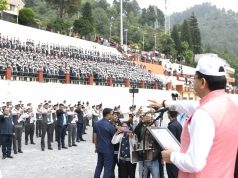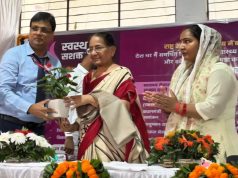Garhwal Post Bureau
Dehradun/Rudraprayag, 28 Sep: The second phase of the Char Dham Yatra began on 15 September with expectations of a renewed surge in devotees. It may be recalled that, till yesterday, over 45 lakh pilgrims, including those bound for Hemkund Sahib, had done the Char Dham Yatra. More than 15 lakhs had offered worship at Kedarnath alone. But in contrast to these figures, persistent rainfall, infrastructure damage and calamities along the route have sharply diminished the flow of pilgrims to Kedarnath Dham, resulting in serious distress for the local population dependent on pilgrimage-driven commerce.
Traders and hoteliers in Gaurikund, along the trek routes and in villages en route to Kedarnath have voiced grave concern that deficiencies in government planning, lacklustre execution and delayed remedial action have undermined the conduct of this year’s yatra. Despite the end of the monsoon season on paper, arrivals remain far below the expected numbers during the second phase of the Char Dham Yatra which begins at the end of the Monsoon season. Many stakeholders allege that the state government, despite repeated warnings and forecasts of extreme rains, failed to make adequate preparations or communicate safety assurances to potential pilgrims.
According to office-bearers of the Gaurikund-Kedarnath Mazdoor Sangh, the Kedarghaati region did not experience a single large-scale disaster this season; neither the temple precincts nor the pedestrian route saw complete collapse. Yet from the very start, the yatra suffered setbacks: in the initial days horses and mules used to ferry pilgrims fell ill, some died, and for days the movement of horses and the mules had remained suspended. Just when animal transport began to recover, helicopter mishaps and successive spells of rain disrupted operations further. The cumulative impact of these adversities across Uttarakhand served only to compound the drop in footfall.
Among the calamities, landslides triggered by unrelenting monsoon rains blocked over 100 roads in the state, including critical stretches of the Kedarnath route. One landslide along the Sonprayag–Gaurikund corridor near Mankutia stranded dozens of returning pilgrims and forced temporary suspension of yatra traffic. In another instance, over 2,000 pilgrims had to be evacuated after a massive landslide rendered part of the highway impassable; restoration of that stretch reportedly took several days. At least two pilgrims lost their lives when debris from a hillside had struck a vehicle near the route, and six others were injured, an incident that prompted the officials to suspend the yatra until safety assessments were completed. Meanwhile, helicopter services, already a lifeline for those unable to trek, had been suspended until mid-September following a fatal crash in June that claimed seven lives, resulting in thousands of ticket cancellations and financial losses to operators and pilgrims alike. Continued bad weather also prompted the government to keep chopper services suspended during the monsoon period this year.
In many days during July and August, daily pilgrim numbers plummeted. Where earlier Kedarnath was witnessing over 20,000 visitors a day, numbers slumped to just 4,000 or fewer during peak disruption periods. In mid-season, some days witnessed as low as 10 percent of the expected arrivals reaching the Kedarnath Dham. This shortfall has hit every segment of the pilgrimage economy. The hoteliers, guesthouse operators, roadside stalls, dandi-kandi operators, mule and horse contractors, porters and guides are now reportedly struggling to meet operational costs, and many face mounting debt.
Union patron Avatar Singh Negi described this season as particularly disheartening. He remarked that despite hopes that the second phase would revive momentum, only ten percent of pilgrims are reaching Kedarnath during the second phase. He criticised the government for its absence on the ground, noting that neither the chief minister nor any other minister visited Kedarnath during the yatra to encourage devotees or offer reassurance. Local traders, many of whom had taken loans to expand their businesses anticipating robust pilgrimage traffic, now find their ventures on the brink of ruin.
The locals are seeking urgent action in this regard though they are aware that only a few days remain in the yatra season. They want that the government must aggressively promote pilgrimage, extend necessary logistical support, ensure route safety, and reassure devotees of secure travel. Without such measures the final weeks may not compensate for the seasonal losses.
The lack of pilgrims has left hotels half empty, teashops deserted, and mule stands idle. Many local families that had invested in seasonal infrastructure—from tents to catering setups—are now scrambling to cover fixed costs like lease, salaries and maintenance.
What adds to the locals’ frustration is that this is not the first time rains have disrupted the Char Dham route this season. Earlier, the yatra had been suspended for five days in September after continuous downpours and flash floods, prompting restoration of damaged roads and urgent repair protocols. In view of record rainfall events in Himalayan states this monsoon. Unofficial sources claim that over 765 incidents of very heavy precipitation, occurred this season which led to huge damage to roads, bridges and terrain stability was never far behind.
However, it is not just Kedarnath alone that has suffered a lesser footfall during the second phase. A 100-metre stretch of the Yamunotri highway, a crucial route for pilgrims, had recently collapsed under heavy rain, yet another instance of how fragile infrastructure is under extreme weather stress. In Uttarakhand this year the Char Dham yatra has faced its worst disruption since the catastrophic 2013 floods. Pilgrimages to Gangotri and Yamunotri were suspended for over twenty days each, while Badrinath and Kedarnath saw pauses as well, contributing to deep revenue losses for local economies.
In Kedarnath valley, it is not just the damage to personal properties like farms, houses and shops, etc., which matters! Many families survive entirely on income generated during yatra months, and the sudden drop in visitors means a loss of vital seasonal earnings. The cost of living in mountain zones remains high, and with no buffer, farmers, shopkeepers and service providers are now demanding relief and loan waivers, or emergency support from the administration.







